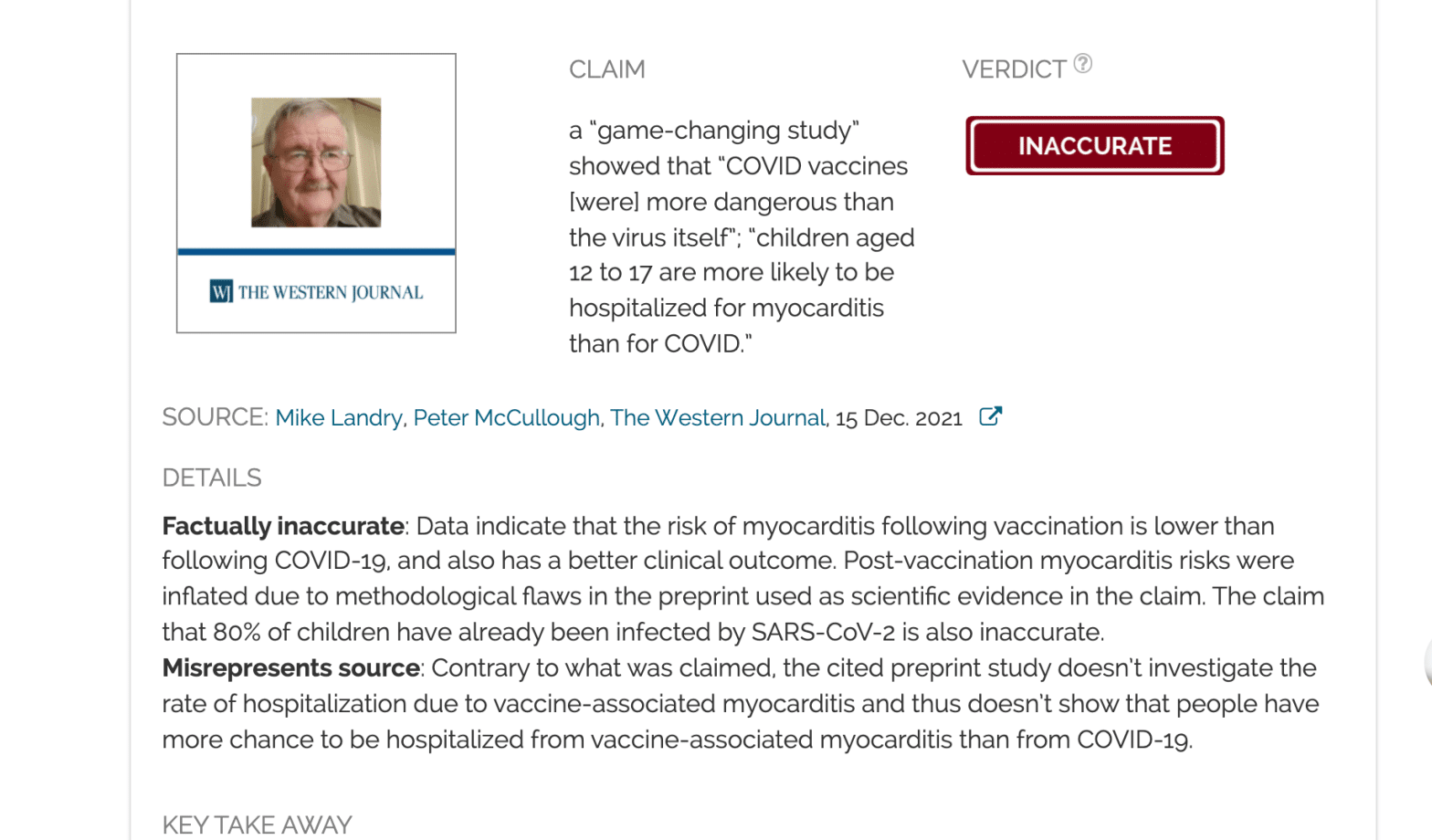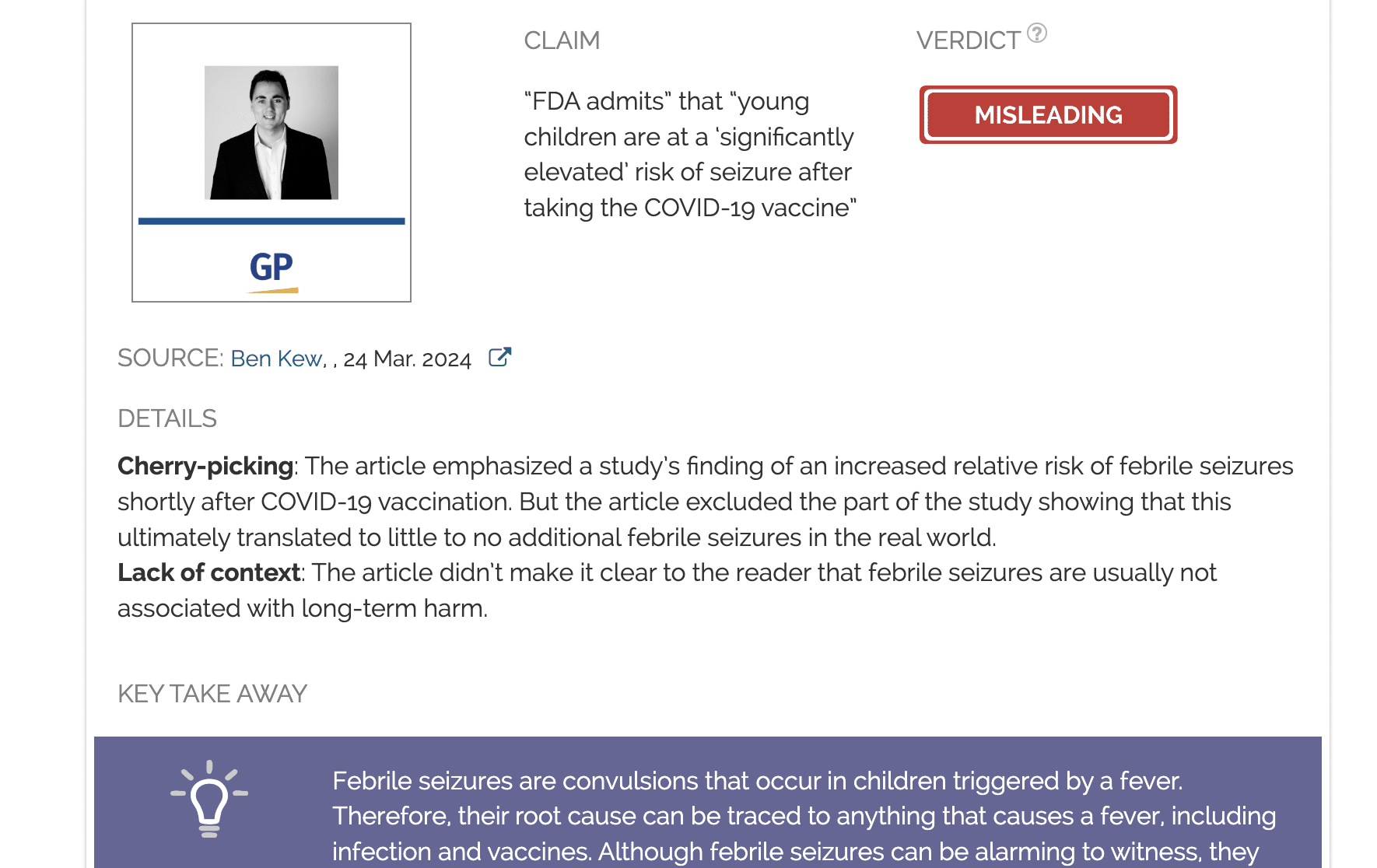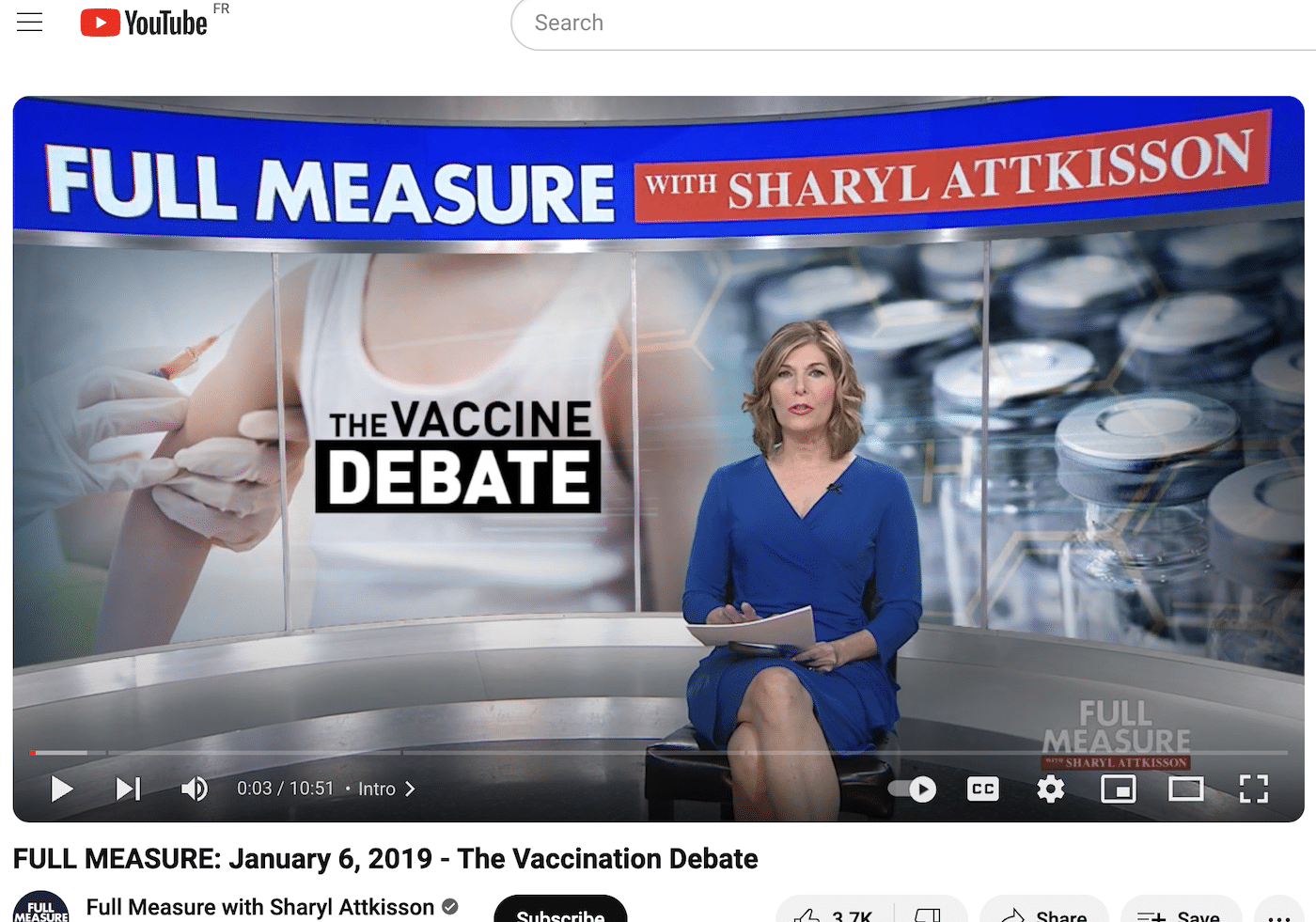- Health
Contrary to Peter McCullough’s claim, getting vaccinated is safer than getting COVID-19, in spite of rare cases of myocarditis
Key takeaway
Although cases of myocarditis have been reported following mRNA vaccination against COVID-19, the cases are rare, usually mild and patients rapidly recover. In contrast, COVID-19 is associated with a higher rate of myocarditis with potential risks of clinical complications. Overall, based on all scientific evidence available, the benefits of vaccines largely outweigh their risks.
Reviewed content

Verdict:
Claim:
a “game-changing study” showed that “COVID vaccines [were] more dangerous than the virus itself”; “children aged 12 to 17 are more likely to be hospitalized for myocarditis than for COVID.”
Verdict detail
Factually inaccurate: Data indicate that the risk of myocarditis following vaccination is lower than following COVID-19, and also has a better clinical outcome. Post-vaccination myocarditis risks were inflated due to methodological flaws in the preprint used as scientific evidence in the claim. The claim that 80% of children have already been infected by SARS-CoV-2 is also inaccurate.
Misrepresents source: Contrary to what was claimed, the cited preprint study doesn’t investigate the rate of hospitalization due to vaccine-associated myocarditis and thus doesn’t show that people have more chance to be hospitalized from vaccine-associated myocarditis than from COVID-19.
Full Claim
a “game-changing study” showed that “COVID vaccines [were] more dangerous than the virus itself”; “children age 12 to 17 are more likely to be hospitalized for myocarditis than for COVID.”; “ 80 percent of children in the U.S. already have had COVID. And they and everyone else who has had COVID are protected by natural immunity.”
Review
Clinical trials showed that the Pfizer-BioNTech COVID-19 vaccine was safe and effective in the five to 15-year-old population[1]. However, data collected from vaccinated people post-authorization revealed that this vaccine was associated with an elevated risk of myocarditis, a type of heart inflammation, mostly among young male, although still rare and normally benign[2,3].
This fact has often been exploited by attempts to spread misinformation about COVID-19 vaccine safety for teenagers. On 15 December 2021, the Western Journal published a news report about an interview by Peter McCullough, a cardiologist. The Western Journal claimed that a “game-changing study” showed that “COVID vaccines [were] more dangerous than the virus itself”. More specifically, the Western Journal claimed that, according to McCullough, “children [aged] 12 to 17 are more likely to be hospitalized for myocarditis than for COVID.”
The study used as the scientific basis for these claims is a preprint—a scientific study whose results and methodology haven’t been reviewed and validated by other scientists yet— by Høeg et al. released in September 2021[4].
Health Feedback reviewed these claims. As we’ll show below, the aforementioned study doesn’t support some of the claims made in the Western Journal piece. Furthermore, the study itself suffers from several biases that invalidate its use as a scientific basis.
To understand why, we first need to understand the methodology of that study. The authors searched the U.S. Vaccine Adverse Events Reporting System (VAERS) database for reports of myocarditis in teenagers 12 to 17 years of age who had been vaccinated against COVID-19. VAERS provides the general public and healthcare workers with an avenue to report adverse events occurring in people after vaccination.
The authors then looked at the proportion of suspected cases of myocarditis among the population of vaccinated teenagers as provided by the U.S. Centers for Disease Control and Prevention (CDC). At the same time, they looked at the pediatric hospitalization rate following COVID-19, also provided by the CDC. The authors then concluded that the risk of myocarditis among vaccinated teenagers was higher than the risk of COVID-19 hospitalization for all teenagers.
As the above demonstrates, the study by Høeg et al. didn’t look at the number of hospitalizations due to myocarditis. While it attempted to calculate the rate of myocarditis linked to vaccination, it didn’t look specifically at the cases of myocarditis that necessitated hospitalizations. Therefore, the study doesn’t actually provide the Western Journal and McCullough with a basis to compare the risks of hospitalization following vaccine-associated myocarditis and COVID-19.
The preprint used as scientific basis by the Western Journal and McCullough presents significant limitations
The Høeg et al. study itself came under criticism for its biases and limitations, as we’ll detail below. Therefore, this isn’t a “game changing study” providing scientific evidence for comparing risks between COVID-19 vaccines and the disease as claimed by Western Journal.
One of the problems is that the study used the VAERS database to collect the cases of myocarditis. As Health Feedback previously explained many times, the database alone cannot be used to determine the existence or frequency of a given vaccine side effect. This is firstly because anyone can submit a report to VAERS, therefore the information in the report isn’t verified. VAERS clearly warns users relying on the database about this caveat: “Some reports may contain information that is incomplete, inaccurate, coincidental, or unverifiable. Most reports to VAERS are voluntary, which means they are subject to biases.”
Secondly, VAERS data can’t show whether one health event is the consequence of a given medical intervention such as vaccination. Indeed, simply because event A occurred before event B doesn’t mean that A caused B.
In order to use data from VAERS, the case reports must first be adjudicated by experts to determine whether they are indeed proven cases of vaccine-induced myocarditis. This is what the CDC did in a paper from July 2021. The CDC called on physicians’ expertise and medical record review to determine which reports were confirmed cases of myocarditis and were indeed vaccine-associated[3]. The CDC calculated a rate of vaccine-associated myocarditis lower than what was claimed by Høeg et al.: 40 per million per second doses of mRNA COVID-19 vaccines administered to males, versus 162 per million in the Høeg et al. study.
By contrast, Høeg et al. did not perform this preliminary assessment of the data to make sure that the dataset only contained verified vaccine-induced myocarditis cases. In fact, Dan Freedman, a pediatric neurologist, noticed that several of the myocarditis cases included in the Høeg et al. analysis didn’t fit the definition of a vaccine-associated myocarditis. For instance, several cases occurred among patients who were also infected by viruses, including SARS-CoV-2. Given that viral infections can also cause myocarditis, these cases should have been removed from the study in the absence of additional information[5].
A second problem is that the risk-benefit analysis comparing myocarditis rate and COVID-19 hospitalization rate, as performed by the preprint authors, is questionable. Indeed many myocarditis cases reported among vaccinated teenagers are mild. Jennifer Huang, cardiologist at the Oregon Health & Science University stated on Twitter that pediatric patients recover quickly and cases are easily resolved within a few days.
When interviewed by Scientific American, Sallie Permar, chair of the pediatrics department at Weill Cornell Medicine and pediatrician-in-chief at New York-Presbyterian Komansky Children’s Hospital, expressed the same view. This is also confirmed by a retrospective study of teenage patients with vaccine-associated myocarditis, which showed a quick recovery[6]. Such mild medical conditions aren’t directly comparable to potentially severe COVID-19 outcomes such as Multisystem Inflammatory Syndrome and death.
In order to properly compare the risks of COVID-19 vaccination and COVID-19 infections, we need to compare the frequency of outcomes with comparable severity. This could be comparing the rate of hospitalization or death due to vaccine-associated myocarditis versus the rate of hospitalization or death due to COVID-19. In that regard, the CDC concluded that six deaths due to COVID-19 could be avoided for each million of vaccine doses administered among males aged 12 to 29 years, whereas no deaths from myocarditis were recorded in the CDC study[3].
A third problem is that the preprint authors used a hospitalization rate defined as the proportion of COVID-19 hospitalizations among the whole teenager population as estimated by the National Centers for Health Statistics. Therefore, we’re looking at two different approaches: Høeg et al. looked at the proportion of myocarditis among vaccinated teenagers on the one hand, and the proportion of COVID-19 hospitalization among the entire teenager population on the other hand, whether the teenagers got COVID-19 or not. The correct approach would have been to look at the proportion of hospitalization among teenagers with a confirmed SARS-CoV-2 infection. By using the entire population as the denominator, the study incorrectly reduced the rate of COVID-19 hospitalization.
Another caveat lies within the way Høeg et al. calculated the rates of myocarditis and COVID-19 hospitalization. They arrived at a rate of myocarditis by dividing the number of myocarditis reports in VAERS by the number of vaccinated children. We can assume that reports are flowing into VAERS from everywhere in the U.S. By contrast, the COVID-19 hospitalization rate was obtained from the CDC’s COVID-NET network, which only covers 100 counties over 14 states, which represents about 10% of the U.S. population. It’s unclear whether this is representative of the total U.S. population.
In summary, the Western Journal misrepresented the conclusion of an already flawed preprint in its account of McCullough’s interview. The data presented didn’t show that vaccines are more dangerous than the COVID-19 vaccine, since that is based on a biased comparison of the rates of myocarditis rates and COVID-19 hospitalization rate.
The benefits of COVID-19 vaccination outweigh the risks of myocarditis
Furthermore, the Western Journal and McCullough ignored data showing that the benefits of COVID-19 vaccines largely outweigh the risks. As mentioned earlier, the CDC ran a model estimating how many COVID-19 cases, hospitalization and deaths were averted thanks to vaccination and compared it to the risks of myocarditis. They found that “11,000 COVID-19 cases, 560 hospitalizations, 138 ICU admissions, and six deaths due to COVID-19 could be prevented, compared with 39–47 expected myocarditis cases after COVID-19 vaccination”[3].
The U.S. Food and Drugs Administration (FDA) performed a similar analysis, as reported by Scientific American. The FDA model was more conservative than the CDC’s, as it assumed a lower vaccine effectiveness of 70%, whereas the CDC assumed a vaccine effectiveness of 95%. In spite of this difference in modeling, the FDA also found that the benefits from COVID-19 vaccination outweigh the risks of myocarditis among teenagers, especially when virus transmission in the community is high.
The risk of myocarditis after COVID-19 is higher than after COVID-19 vaccination
While certain COVID-19 vaccines are associated with myocarditis, one must keep in mind that viral infections, including SARS-CoV-2 infections, can also cause myocarditis. A CDC study of the period between March 2020 to January 2021 showed that the risk of myocarditis was 30 times higher among COVID-19 patients under 16 compared to teenagers without COVID[7]. Let’s look at the data comparing the frequency of myocarditis post-vaccination and post-COVID
In one of their fact-checks, FullFact gathered data from published papers and preprints showing that the occurrence of myocarditis was higher following COVID-19 than vaccination against COVID-19. A comment published in Nature Reviews Cardiology also reported that myocarditis was more frequent following SARS-CoV-2 infection[2].
More importantly, the clinical consequences of COVID-19-associated myocarditis are also worse. Several cardiologists interviewed by National Geographic explained that “Myocarditis after the vaccine is rarer and usually milder than the cardiac complications from COVID-19”. Nature Reviews Cardiology also added that “in contrast to the overall mild presentation and good outcome of vaccine-associated myocarditis, COVID-19 is associated with a major risk of cardiovascular complications”[2].
The evidence available indicates that children who tested positive for SARS-CoV-2 remain in the minority; infection-induced immunity is less reliable compared to vaccine-induced immunity
The Western Journal also claimed that children weren’t at risk from COVID-19 because “80 percent of children in the U.S. already have had COVID”, which would make them “protected by natural immunity”. This is likely a reference to infection-induced immunity.
However, the claimed proportion of children who had COVID-19 is inaccurate. The American Academy of Pediatrics indicated that a cumulative 9.8% of children tested positive for SARS-CoV-2. The FDA reported 1.9 million cases among children from five to 11 years of age, which gives a proportion of 7.8% if we consider that the total population of children aged five to 11 is 24.3 million.
Furthermore, it is incorrect to suggest that infection-induced immunity is a “one size fits all” solution that guarantees complete protection against COVID-19; immunity after infection is unpredictable, and some individuals even develop no antibodies following infection. Whether it is more efficient than vaccine-induced immunity isn’t clear.
Conclusion
In summary, a flawed preprint was used to make inaccurate claims about the danger of COVID-19 vaccines. The preprint study contained several limitations due to the quality of data used and the methods used to calculate proportions of myocarditis and hospitalization in teenagers, which invalidated its conclusions. Contrary to the claims in the Western Journal and the preprint, data from health agencies and published studies indicate that cases of myocarditis are rarer and milder following vaccination than following SARS-CoV-2 infection. This is one demonstration showing that COVID-19 vaccines’ benefits largely outweigh their risks.
REFERENCES
- 1 – Frenck et al. (2021) Safety, Immunogenicity, and Efficacy of the BNT162b2 Covid-19 Vaccine in Adolescents. The New England Journal of Medicine.
2 – Heymans & Cooper (2021) Myocarditis after COVID-19 mRNA vaccination: clinical observations and potential mechanisms. Nature Reviews Cardiology. - 3 – Gargano et al (2021) Use of mRNA COVID-19 Vaccine After Reports of Myocarditis Among Vaccine Recipients: Update from the Advisory Committee on Immunization Practices — United States, June 2021. Morbidity and Mortality Weekly Report.
- 4 – Høeg et al. (2021) SARS-CoV-2 mRNA Vaccination-Associated Myocarditis in Children Ages 12-17: A Stratified National Database Analysis. MedRxiv (preprint).
- 5 – Woudstra et al. (2018) Infectious myocarditis: the role of the cardiac vasculature. Heart Failure Review.
- 6 – Jain et al. (2021) COVID-19 Vaccination-Associated Myocarditis in Adolescents. Pediatrics.
- 7 – Boehmer et al. 2021) Association Between COVID-19 and Myocarditis Using Hospital-Based Administrative Data — United States, March 2020–January 2021. Morbidity and Mortality Weekly Report.



